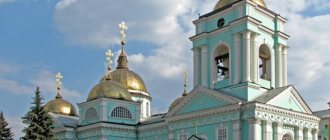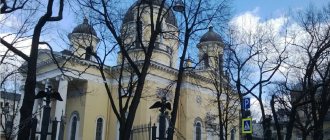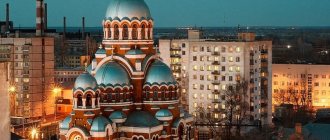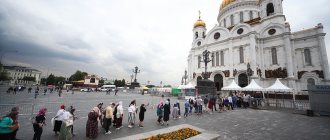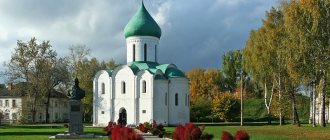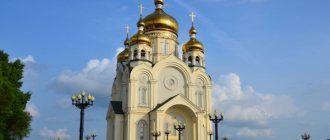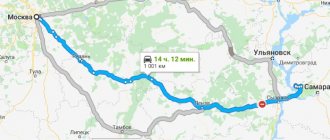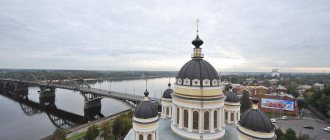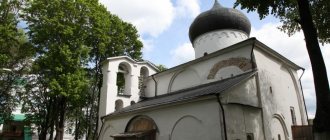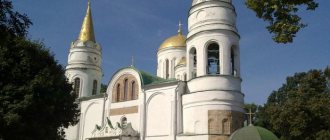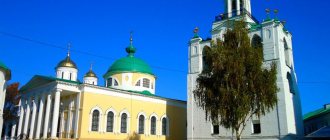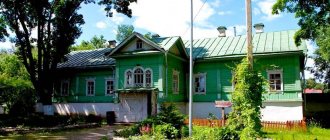History of the Transfiguration Cathedral
The construction of the temple began in the 30s of the 18th century. The decision was made by the youngest daughter of Peter I when she took the throne, displacing the illegally reigning Anna Leopoldovna. Before the start of construction work, the Preobrazhensky Regiment was located on this site. The Tsesarevna often visited soldiers with their families, bringing gifts to the children. On November 25, 1741, a decision was made to attack the Winter Palace, and the grenadiers agreed to support the future empress.
Spaso-Preobrazhensky Cathedral in St. Petersburg
After the coronation ceremony, Elizaveta Petrovna, expressing her gratitude to the soldiers who supported her, decided to give them a temple. The best architects of that time were invited to the construction: Rastrelli, Trezzini, Zemtsov. Thus, St. Petersburg found a new shrine, named in honor of the regiment. Now it is located on Preobrazhenskaya Square (formerly Radishcheva), next to Tserkovny Lane.
How to get there
The Transfiguration Cathedral awaits its guests at the address St. Petersburg, Preobrazhenskaya Square, 1. It is not far from Liteiny Prospekt, Pestel Street and Chernyshevskaya metro station.
Fragment of the map. Saint Petersburg
This is the city center, so you can get there by any transport even from remote areas without any difficulties. Having arrived at the temple for an excursion, you can then go to other numerous architectural monuments, because they are located within walking distance from each other. For example, go for a walk in the Mikhailovsky Garden or to an exhibition in the Russian Museum.
Video “History of the Transfiguration Cathedral in St. Petersburg”
From this documentary you will learn the history of the Transfiguration Cathedral in St. Petersburg.
Construction of the cathedral
The history of construction begins in 1743. The project of a five-domed building in the Russian-Byzantine style was developed by Mikhail Zemtsov, and after his death Pietro Trezzini took over the management.
The first stone was laid by Elizaveta Petrovna with her own hands. While construction was underway, the Empress closely monitored all processes, making corrections and her suggestions. When the construction of the Church of the Transfiguration of the Lord was completed a year later, she personally attended the consecration ceremony.
Second life of the temple
At the beginning of the 19th century, the church was badly damaged by fire. The ignition occurred due to the fault of the workers, and the raging flames left only the walls of the building. Most of the relics (icons, sacristy, utensils) were saved only by a miracle.
By decree of Emperor Alexander I, architect V.P. Stasov was tasked with restoring the destroyed cathedral. The reconstruction was carried out in a very short time, and soon St. Petersburg regained its shrine. The consecration took place in 1829 by Metropolitan Seraphim.
The temple has always been active. Services were held there, parishioners were received, and during the blockade a bomb shelter was built. The building seats about three thousand people, and has a Sunday school and choir. Since 2014, Archpriest Nikolai Bryndin has been appointed rector.
Monument of architecture of late classicism
The area of the Transfiguration Cathedral is 1180 square meters. m, and the highest point is at 41.5 m. The main entrance is framed by four columns, each 12 meters high. The church is crowned with a large dome, on which stands an eight-meter cross. There is a clock on the northwestern bell tower.
The walls of the temple are decorated with moldings depicting military paraphernalia. The windows are rectangular with a rounded top. The Church has three altars. The main one is dedicated to the Transfiguration of the Lord, the southern one is dedicated to Sergius of Radonezh, and the northern one is dedicated to the Great Martyr Clement, Peter of Alexandria and the Pope of Rome.
The area of the Transfiguration Cathedral is 1180 square meters. m
Interior decoration
The Transfiguration Cathedral (St. Petersburg) kept regimental banners, military trophies, and uniforms of Nicholas I, Alexander I, and Alexander II within its walls until 1918. In addition, the same saber that was kept by Emperor Alexander II in early March 1881, when he was mortally wounded, was kept here. These relics were later transferred to the Artillery Museum, and in the middle of the 20th century they replenished the Hermitage collection.
V.P. Stasov, restoring the temple, significantly changed the interior. The four-tiered iconostasis of the central border is decorated with magnificent gilded carvings on a white background. Famous painters worked on the icons: V. Shebuev, A. Ivanov, A. Ugryumov.
Architectural features of the shrine
After the fire, during reconstruction, the temple underwent some architectural changes. The cathedral, built according to the design of Vasily Petrovich, still adorns Preobrazhenskaya Square in St. Petersburg.
Temple fence
The square laid out on the territory of the cathedral was also designed by Stasov. In honor of the victory over the Turks in the Russian-Turkish War, the architect built an original fence. It consists of 102 captured guns taken from enemies at the sites of the main battles.
The muzzles of the enemy cannons are directed downwards, as a sign of the defeat of the Ottomans, and they themselves are fixed in threes on granite bases. The elements are connected to each other by a chain with large links, and on the bodies you can see double-headed eagles crowned with gold crowns. The fence gates are decorated with shields with victory medals.
According to the project of V.P. Stasov, it was planned to build tombs for the dead soldiers, but construction never took place.
Interior decoration
The arch of the main dome rests on four pylons with a diameter of three meters. It is painted with a blue sky and a large star of Bethlehem. It also depicts four evangelists, eight angels, and along the circumference you can read an inscription blessing the Almighty.
Under the dome there is a central chandelier with 120 candles, as well as several smaller lamps. On the right side of the pillar is the royal seat, decorated with symbols of power. On the left you can see the church pulpit, where in gilded letters it is written: “Hear the word of the Lord.”
The main altar has a five-tiered iconostasis, made according to Stasov’s sketches. It is made in the shape of a triumphal arch and decorated with exquisite gold carvings.
History of the temple in the 19th and 20th centuries
In the 19th century, the “Guards” church was very popular in the city. Contemporaries said that St. Petersburg is famous for two churches - the Kazan and Transfiguration Cathedrals.
Since the 1870s, a charitable society was organized here. The money collected was used to maintain an almshouse for the elderly and sick, an orphanage and a canteen. There was a school for soldiers' children at the temple, and there were free apartments. Every August, a large fruit market was held on the square near the building.
After the revolution, the cathedral received the status of a parish church. All military relics of the Preobrazhensky Regiment were transferred to the Artillery Museum. During the years when the country was confiscating valuables in favor of the famine-stricken in the Volga region, many ancient icons disappeared from the cathedral without a trace.
During the Leningrad blockade, a bomb shelter was made in the basement of the church. During artillery shelling and bombing, up to 500 people hid in it. Doctors and nurses also worked here to help the wounded. During the most difficult years, services did not stop.
When the war ended, parishioners and city authorities found funds to restore the facades and interiors of the cathedral. In 1950, military banners, standards, weapons, trophies of guardsmen and Preobrazhensky uniforms of several Russian sovereigns ended up in the Hermitage storage rooms.
Shrines and relics of the Transfiguration Cathedral
The main pride of the temple is the Image of the Savior Not Made by Hands and the icon of the Most Holy Theotokos “Joy of All Who Sorrow.” The first shrine, depicting a close-up of the face of Christ, was especially loved by Peter I. His mother gave it to her son, and later the icon was next to the emperor during the founding of St. Petersburg.
No less valuable for the cathedral is the image of the Mother of God of Tikhvin. It is decorated with precious stones that make it uniquely beautiful.
In the northern part of the temple you can find a warehouse donated to the church by the commander of the Preobrazhensky regiment, Konstantin Konstantinovich. It depicts the holy martyrs Constantine and Panteleimon.
The temple also keeps a memorial plaque with the names of officers of the Preobrazhensky Regiment. The list includes all deaths from 1702 to 1917.
Icon of the Most Holy Theotokos “Joy of All Who Sorrow”
Image of the Savior Not Made by Hands
Interior of the temple
Finally
I told you about the temple, whose fate is closely connected with the history of Russia: with all its joys and tragedies, celebrations and losses. Nowadays, the Transfiguration Cathedral is one of the most visited churches in the northern capital.
Here you can hear the wonderful voices of a unique church choir, in which the best singers of the academic choir take part. I was once forced to involuntarily get acquainted with this amazing cathedral by banal bad weather in St. Petersburg, for which I was very grateful as a result. Now I can definitely say that everything that happens to us happens for the better.
I sincerely invite you to go beyond this historical fence and, having passed the square surrounding the cathedral, find yourself under its majestic arches.
It is usually not crowded and very quiet here during off-duty hours. The bustle of the metropolis left outside is somehow immediately forgotten, and with the glow of candles and lamps one imagines the glint of epaulettes on the uniforms of the glorious Preobrazhensky Regiment.
Cultural and educational activities
The role of the Transfiguration Cathedral for the Orthodox life of St. Petersburg is difficult to overestimate. A Sunday school for adults and children has been established on its territory. There, parishioners not only study Orthodoxy, but also learn choral singing. In addition, the church has its own social service. Its employees provide free assistance to all those in need: they distribute things, feed, and help the homeless and poor.
There is a Holy Scripture circle in the temple. There, those interested are taught to correctly read and understand the texts of the Gospel. There is also a youth club. It helps young parishioners join the Orthodox faith, discuss topics of interest with like-minded people, and receive help or advice.
Also, ministers of the Church of the Transfiguration of the Lord conduct catechetical conversations with those who have decided to devote themselves to church life or take part in certain rituals.
You can visit the Transfiguration Cathedral on any day of the week from 8:00 to 20:00. Services are held according to the following schedule:
- 10:00, daily – morning services;
- 7:00, twice a week – reading of the Liturgy;
- 18:00, every day – evening services.
More information about the schedule of services, excursions and the latest news from the Orthodox life of St. Petersburg can be found on the official website: https://spaso-preobr-sobor.ru.
The Church of the Transfiguration of the Lord is not the only architectural monument associated with the war. In addition to it, the Northern capital is famous for the Kazan and Holy Trinity Izmailovsky Cathedrals.
If you find an error, please select a piece of text and press Ctrl+Enter.
Pre-revolutionary activities of the cathedral
Large-scale missionary service was carried out at the cathedral. Here they organized their own charitable society, containing an almshouse, an orphanage, a canteen, a school for children of military personnel and free housing.
I think I need to mention to you another important function of the cathedral. Since 1912, the “Brotherhood of Temperance and Chastity” operated there, organized by the priesthood with the support of parishioners. At that time, there were many similar societies in Russia, which spontaneously appeared in 1858 and marked the beginning of a large movement for sobriety, in which the church took an active part. After the revolution, this tradition was lost, but today it is again gaining popularity in some churches.
On the Feast of the Transfiguration of the Lord, or, as people say, Apple Savior, on August 19, a traditional fruit market was held near the cathedral.
Unfortunately, today this tradition has been preserved only in stories about bygone times. Although fruit lighting still occurs today.
Memorial fence
In 1828-1829, Russia and the Ottoman Empire fought with each other. After the war, the Peace of Adrianople was concluded. Russia received most of the eastern coast of the Black Sea and the Danube River delta. 10 thousand Russian soldiers died in bloody battles. Another 5 thousand died from wounds, and 110 thousand died from disease during the marches.
Main entrance to the Transfiguration Cathedral
In memory of this war, an unusual fence was built around the cathedral from captured cannons obtained in the battles for the fortresses of Izmail, Tulcha, Varna, Silistria and Isakchi. By decree of the Russian Tsar Nicholas I, the Guards Cathedral was presented with 18-pound and 24-pound guns.
On the cast iron barrels you can see the Ottoman coat of arms and the names that the Ottomans gave to the cannons: “Sacred Crescent”, “Wrath of Allah”, “I give only death” and “Spewing Thunder”. There is nothing surprising in the fact that the guns were named. The names of the guns were also cast in Russia. The famous cannon maker Andrei Chokhov made the “Wolf”, “Skoropea” and “Lion” squeaks.
The temple fence has 34 granite bases, each of which has three cannons. The guns are placed with their muzzles facing the ground. This means that they will never participate in war again.
On the main gate you can see enlarged copies of the commemorative medal. On one side there is a laurel wreath and the inscription “For the Turkish War”, and on the other there is a cross over a defeated crescent and the years “1828-1829” are indicated. The same gilded cross adorns the top of the gate.
Main gate with copies of commemorative medals on the doors
The middle cannons on the pedestals are completed with gilded coats of arms of Russia - double-headed eagles. Massive cast iron chains are stretched between the granite bases and the tools. After the revolution, the cross on the central gate and the eagles were removed, but in 2004 the memorial fence was restored to its original appearance.
